LG 29EA93 Monitor Review - Rev. 1.25
by Chris Heinonen on February 12, 2013 8:49 PM ESTLG also offers its own hardware and software calibration package for the 29EA93. Using a custom designed colorimeter, the hardware and software only work with LG monitors but are scheduled to sell for less than competing products from XRite and Datacolor. I mentioned earlier in the review that colorimeters are prone to errors on displays with LED backlights like the LG. This is a general rule, but since LG knows the spectral response of their displays they can program that into their own colorimeters, leading to much better results than a generic colorimeter. It usually won’t be as good as a meter profiled with a spectrometer due to sample variations, but it will be much better than without.
Using their own software and probe, I calibrated the display to the same settings I use: 200 cd/m² and a gamma of 2.2. An sRGB gamma curve is not supported, nor are colorspaces larger than sRGB with this version, but on their professional monitors with a more advanced meter, different colorspaces are supported. The process is very simple: You choose your targets, it will pop up a spot for the calibration puck on screen, and then you let it run the calibration. The process locks the monitor OSD controls as it adjusts it automatically, and then at the end it will create an ICC profile for you and install it.
To evaluate this profile, I again used CalMAN and used the same set of images that we use for our smartphone and tablet testing. Using the automated test pattern generator in CalMAN wasn’t possible, as it would attempt to load its own ICC profile and change the setting in the display. On first look, we see 197.3 cd/m² of light output and 0.19 cd/m² on a black screen for a contrast ratio of 1039:1. This wasn’t as good as I was able to achieve using CalMAN, which might indicate that it is obtaining the peak-white level differently. With CalMAN I could use the Contrast and Brightness controls to get just above 200 cd/m², allowing maximum headroom to adjust the curves to get accurate color. The LG software might not bring these down as much, and then bring down the RGB curves even more, which would lower headroom compared to the other method.
Our CCT average is 6415, but a look at the RGB balance shows that it starts out very good but then drifts a little towards the warmer, redish tint that the CCT reflects. Gamma is almost spot on at 2.21, save for a dip at 5% that most people won’t catch as they only measure in 10% increments. The dE2000 values follow the RGB balance as well, starting out very low but eventually drifting up to a level where a reddish tint will be slightly visible. The average dE2000 for the grayscale is 2.09, a number that is decent but not as good as CalMAN was able to achieve.
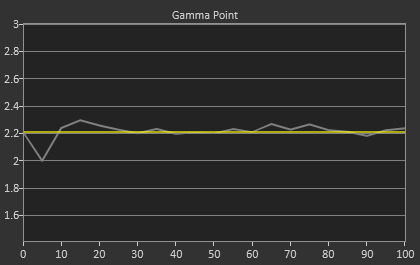
Looking at the Saturations and Color Checker charts, we see improvements but not to the degree that CalMAN allows. Our Color Checker dE2000 is 1.96, but with higher grayscale errors as well as larger errors in the over-saturated colors of red, yellow, and green. Blues also exhibit a bit of over-saturation as well, indicating that the LG sensor isn’t quite as sensitive as the C6 colorimeter, since blue is harder to read.
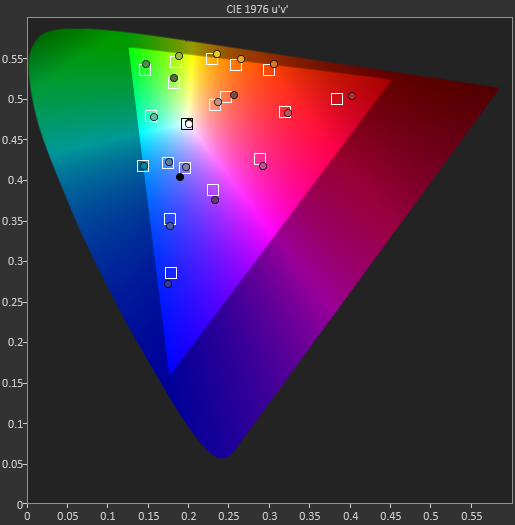
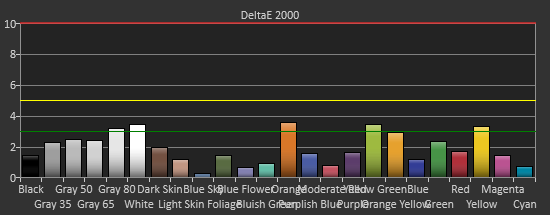
On the saturations data, we see that the Red/Yellow/Green side of the triangle has larger and larger errors as those colors get more saturated. With the over-saturated gamut, this is what we expect to see. Unfortunately none of the calibration software seems to be able to fully pull those points in and correct the over-saturated gamut there, leaving a bit of an error. The overall error is still fairly low, and with most colors not being fully saturated, that over-saturated error isn’t really bad, but better results were obtained with the CalMAN software.
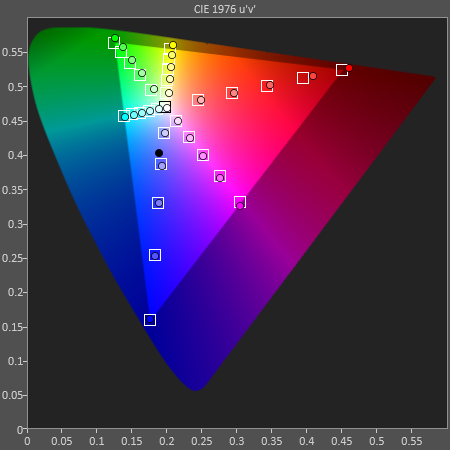
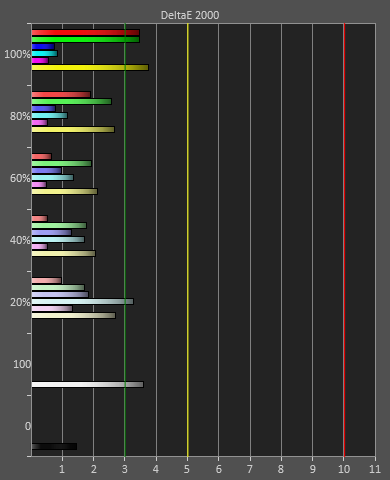
Overall the LG software and hardware solution does do a decent job, but it can’t compete with what is possible using CalMAN with better hardware. Of course, the CalMAN solution with a C6 and i1Pro meter retails for closer to $2,000 than $100, so they are very different spectrums of performance. For $100, I would say the LG results are quite good and will satisfy those that aren’t graphics or video professionals most likely. Just the superior gamma will make a large difference when viewing thanks to the superior dynamic range.








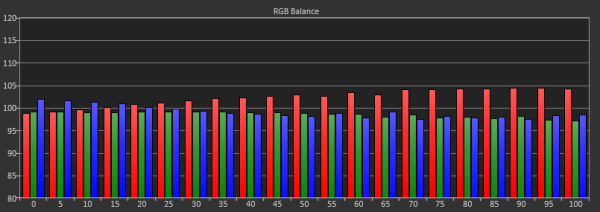
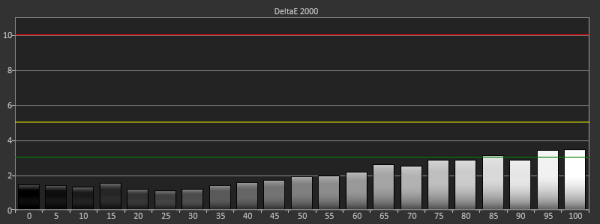








108 Comments
View All Comments
cheinonen - Tuesday, February 19, 2013 - link
I don't add calibrated settings for a reason: They're specific to that display, and that one only. The level of tolerances on a consumer panel is high enough that just plugging in the settings from someone is no guarantee that the image will be better or worse, just different. And since it can be just as easily worse as opposed to better, I don't provide them. Otherwise I know it will result in many people getting those settings from somewhere else, or without a disclaimer like this, using them, and then posting "The AnandTech settings made my display worse, they have no idea what they're talking about".If the display has a mode that is more accurate, I typically mention which one I used for calibration so everyone could use that specific mode, buy beyond that and adjustments are just as likely to make a display worse as better.
SpartanGR - Tuesday, February 19, 2013 - link
Don't bother with this monitor yet. There's no 1.25 version out there.Adrianojp - Tuesday, February 26, 2013 - link
Hi,This is my first post, but I have been reading your site for years now.
Thank you for all your great work!
Response times: in your 1.25 review, you state that RT's have been tested at 1080p resolution because of some CRT limitations. Could you please iron this out for me?
I am a hardcore FPS gamer, and am out shopping for the fastest 27-30 monitor out there! This would be very interesting because of it's huge landscape, but lag is a no no!
mcfrumpy - Monday, March 11, 2013 - link
So I noticed that now Newegg and Microcenter are carrying this monitor. There's a guy on the HardOCP forums that bought one and is doing a review. The picture he took of the back shows a manufacturer date of January 2013, but a rev00. I know they weren't released in the US officially so for all I know rev00 is the 1.25 here, but seems kinda risky to buy without knowing for sure.carloverthepond - Tuesday, March 19, 2013 - link
I purchased this monitor from South Korea arrived with build date Dec 2012 Rev 00 shockingly poor panel over 30 stuck/dead/live pixels. This month I purchased one from Frys again build date Dec 2012 Rev 00, then one from MicroCenter yet again build date Dec 2012 Rev 00. The money I have lost in shipping and restocking fees is now a joke. Currently awaiting one I ordered from Newegg arrives 03/22/13 their website photos show build Feb 2013 Rev 01, so how do we know if this is revision 1.09 or 1.25. After several conversations with LG USA they posted the comment below on Neweggs website, how can you truly tell what revision you have when it's not labeled clearly and manufacturer just says it's revision 1.25 are we to take their word? If anyone has any idea how to identify which revision other than sticker on rear of panel? An LG USA have been very clear they will NOT update older revisions to their knowledge they don't even have the means to do so.Manufacturer Response:
1. The older version is neither defective nor low quality. It was just a running change to update the firmware
to newer versions (like is done with other electronics).
2. Currently, there hasn’t been any game resolution support issues reported for this model. Please contact us with
any issues you find so we can test. Our previous internal testing did not find any resolution support issues for
any games. Also, Software version is not related to resolution support and different versions do not effect ability
to support full 2560 x 1080 resolution.
3. All of models sold to newegg.com are firmware version 1.25.
Please call us with any more questions. 800-243-0000.
carloverthepond - Thursday, March 21, 2013 - link
Received new monitor today from newegg and the manufatures response is incorrect, newegg are selling revision 00. So some people get the new revision and others like me yet again get the old one. This will now be my fifth monitor, will I ever get the new revision. Is it accurate that rev 00 is really 1.09 and rev 01 is 1.25?5150Joker - Saturday, March 23, 2013 - link
Your guess is as good as mine. I picked up an LG 27EA83-D from Fry's which just recently received a firmware update of its own with similar results as the panel you bought. However mine was manufactured in Jan 2013 and is Rev 00. I wrote LG USA about it and they had no clue (surprise surprise). So right now I'm trying to get a hold of someone in Korea that can provide firm answers. Otherwise as much as I love this display, it might go back to Fry's.rogerRion - Wednesday, March 27, 2013 - link
1.09 / 1.25what do i have?
the same in germany.
A) isnt there a way to find out which revision do you really have? maybe with powerstip on the DDC data?
B) is a simple Firmware Update (like on CDRW drives) possible, or is this thought technical not logical?
SpartanGR - Monday, April 1, 2013 - link
A. Unfortunately noB. No again for some reason but i strongly believe that it may well as be diff. electronics along with diff. firmware
dim.thelights - Thursday, April 4, 2013 - link
How to know which Rev. you will buy in the shop?Anyone know how to find out?